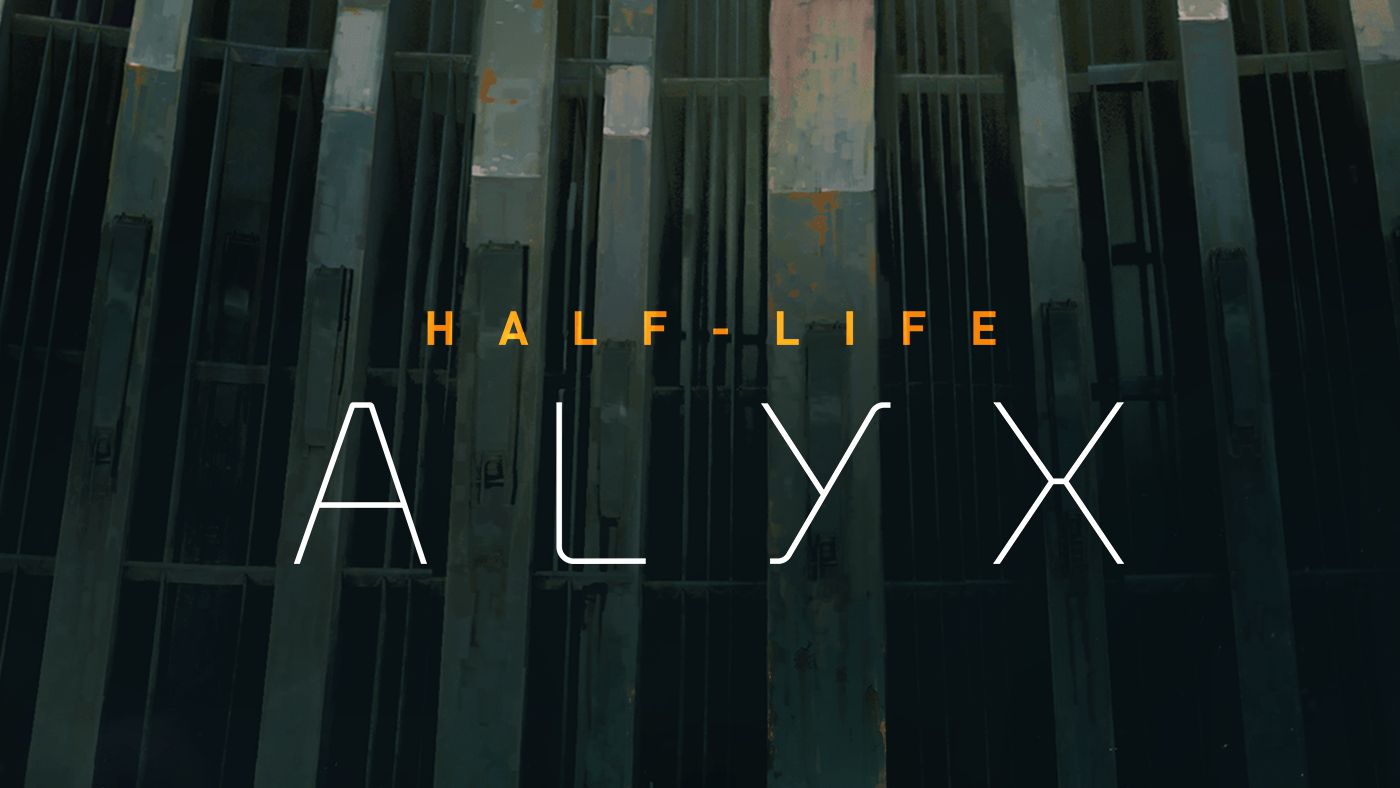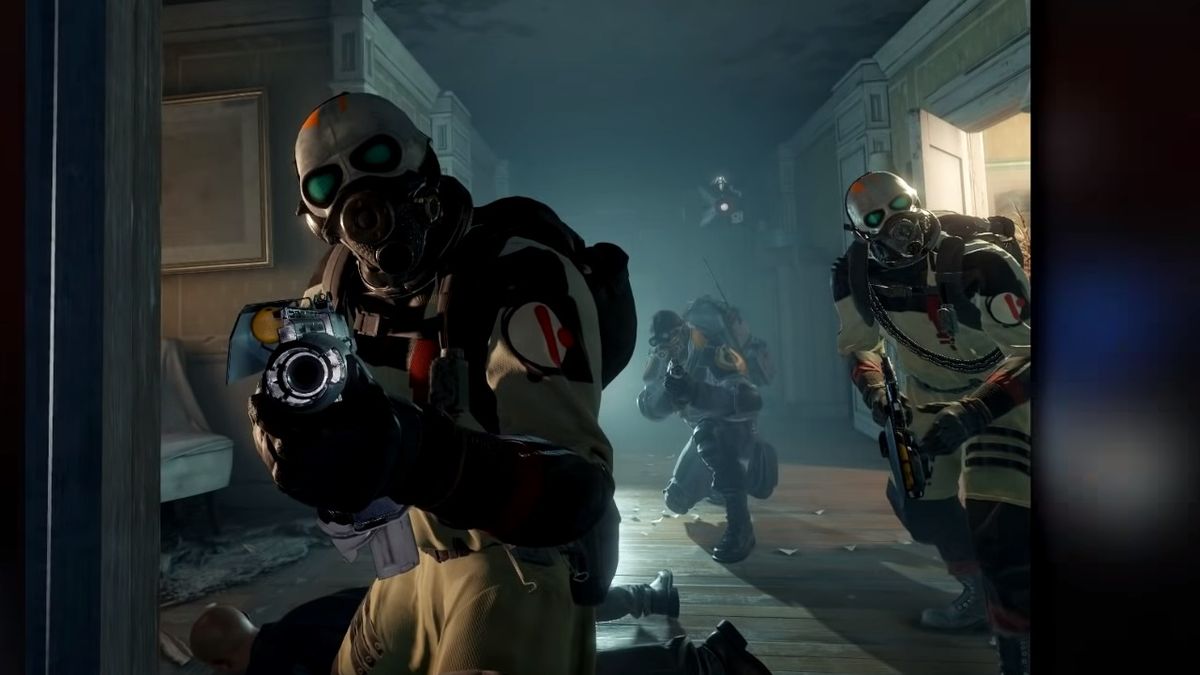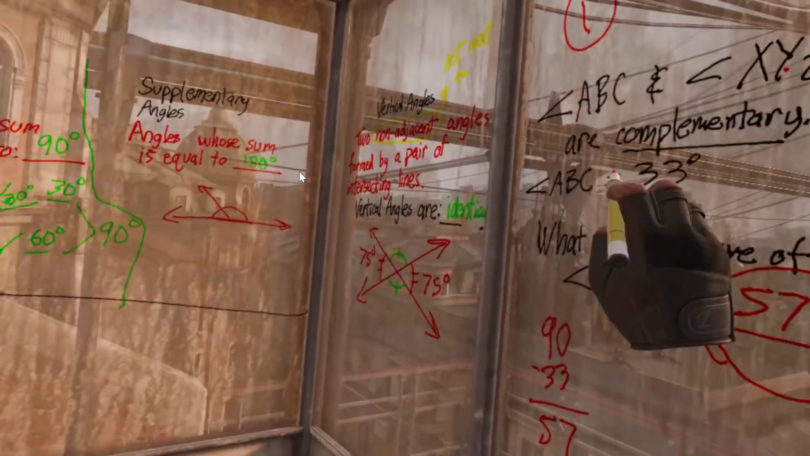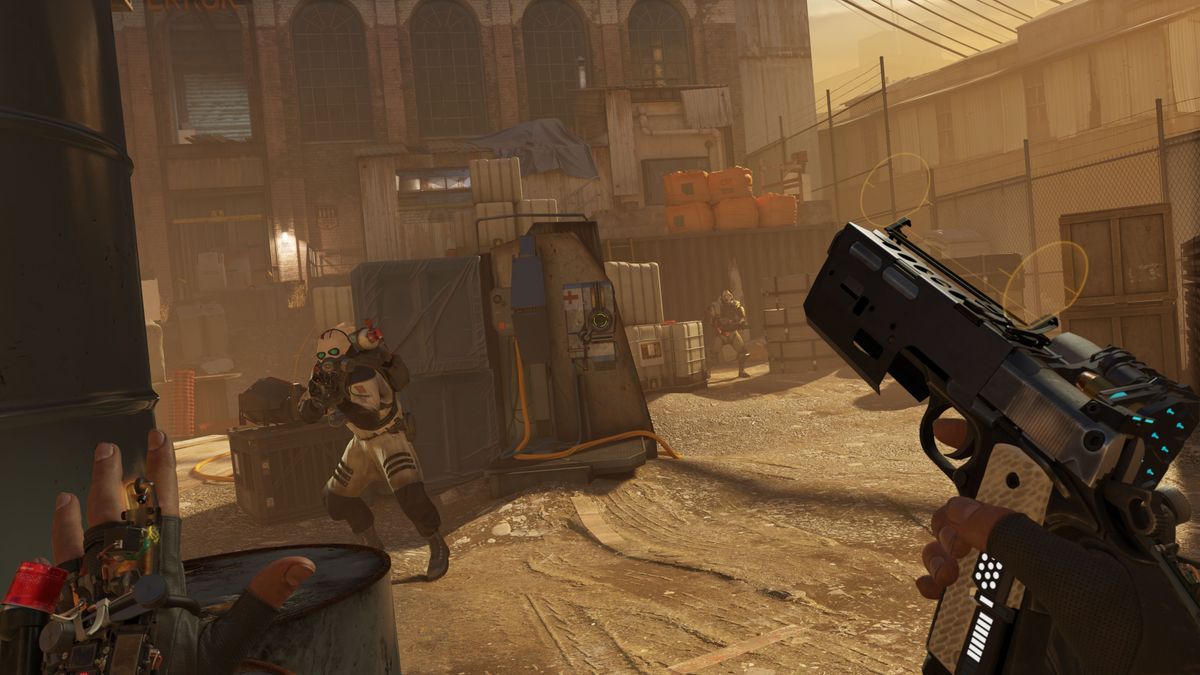In the immortal wise words of Roy Chubby-Brown:
"Oh, I don't know why Gordons leaving, or where he's gonna go, I guess G-Man's got his reasons, But I just don't want to know,
Coz for thirteen years, I've been waiting to spend time with Alyx,
Alyx? Who the the f--- is Alyx?
Yes, thirteen years just waiting for a chance, to get a VR game all about my fave girl Vance, Now I've got to get used to motion sickness as I play as Alyx,
Alyx? Who the f--- is Alyx?"

So, the game has eleven chapters meaning I'm still early on it after last nights introductory experience which see's me currently around the tail end of Chapter 2. As a result there's a lot I've yet to experience as combat hasn't even been introduced properly yet, the game easing the player in as they go along. It's quite an interesting experience to be honest, playing a game that has gone all out to deliver a comprehensive and full scale VR experience that is uncompromised. So far it's left me with a mix of feelings, it feels like Alyx is simultaneously final proof of all of VR's strengths but also why it's doomed to decline in the coming years - a thought I'm hoping the meat of the game can erase given the high risk that might get compounded further.

First thing is that the game's visuals hold up strong throughout. It's not that Source Engine 2 is some sort of amazing powerhouse for visuals but more that the art style approach Valve have taken is to take what Half-Life 2 delivered all those years ago and to update it which means with the advancements in minor details, lighting and textures the game comes across as very clean looking which is the ideal approach as it works well with the displays VR headsets have, minimising moments where details are blurred or unclear.
Movement would probably be the next key area and as Alyx is a rolling adventure (bar the disappointing inclusion of early 2000-era mid-level breaks for loading the next section of level) then locomotion will be a concern for many. The game has four main options for movement which are:
Blink - Where you select where to move to and the screen briefly blanks out and returns in the next location
Teleport - The common system where you choose where to move to and then you shift to that location
Continuous - Where you move via analogue stick with direction guided by your headset
Aimed - Same as Continuous but more guided by the positioning of your hands
I have it set to the last one which is the worst for motion sickness but my sea legs seem to be fine with it. I absolutely hate teleport in every VR game, it's immersion breaking and in one motion establishes why VR is limited. I find the targeted locomotion is stuttery but maintains the sense of immersion much more because you're always in the environment.

There's already been talk both from fans and Valve themselves about the high likelihood of someone modding the game to allow non-VR players to work through the game. As much as the experience would be diluted by this I can kind of see how it would be done but without other tweaks people may find it too pedestrian. Movement is slow, a lot slower than most other games, but that is to manage the risk of motion sickness so in VR you don't mind that the game is a more considered pace of experience than past entries. On TV it may make the game too plodding and whilst modders could speed Alyx up I imagine it would mess up enemy encounters.
So far I can switch between a multitool used for puzzles, an empty hand or a pistol. You aim and yank items toward yourself with the gravity gloves and catch them mid-air. Items are stored in your backpack which is done by putting the item over your shoulder as an action. Now, this brings me around to interactivity. From the moment the game opens there are objects around that you can interact with and I was surprised that there was actually less interaction than I expected. You can pick up pens and draw on objects, all doors are opened as you would in real life, you manually load your weapons, you can pick up matchboxes etc. But many of the objects are static, I picked up a matchbox and prodded its tray with my finger but nothing happens. Press the top of a spray can and the same - nothing. It's a very small thing but I think it says a lot that I thought something would happen, that nothing did kind of scaled back my expectations of the game because this is a big budget major release and it shows that when a convincing level of immersion is achieved it can still so very easily be broken by the smallest details. There are lots of moments of interaction, it's just so far I'm finding them to be fairly signposted and typical examples like you'd see in other VR games.

I think that's pretty much how the game comes across so far. VR is awash with small experience games and experimental titles exploring the various advantages of virtual reality. So far Alyx feels like it is answering the question of what happens when you refine, polish and create a traditional single player FPS campaign with all of these elements. Everything about the game feels polished but at the same time many VR quirks such as motions not always being recognised, the issues with locomotion solutions etc still exist. Almost like a compendium of the finest of what VR can do whilst not really bringing any solutions to what VR can't do.
Another key question some may have - Valve Index. The biggest feature that that headset has is the individual finger tracking, Index is an expensive entry point to VR but much has been made of its features and how Alyx is built with it foremost in mind. I won't lie, so far I haven't experienced a single instance where the ability to move your fingers individually would have been used, be beneficial or even a fun novelty so far. Again, maybe later something will come up but given the price jump can be north of £600 extra to play this game via Index over other options it would be wrong to suggest that so far there's anything to suggest Index would actually bring anything to the table to warrant that cost.
I don't want to underplay the game too much though. Like I said, I'm early on in and there's lots of playtime remaining for it to bring ideas to the table and to mix up gameplay scenarios. It's also very clear from the outset that there's a very real likelihood that Alyx may well be the finest of all VR games on the market. It would take some major mis-steps for the game to not end up being a game that warrants 9 or 10 out of 10 scores. There's a difference though between whether a game is say a 10/10 VR game or a 10/10 game compared to all games in all forms and that I'm more on the fence about at the moment.
I'm definitely going to go slow with the game though, it deserves to be savoured as it's a unique experience purely by its nature. This is a 13-15 hour high budget single player campaign adventure made by a company that doesn't need to concern itself by the development costs incurred by this and the likelihood that it won't be a big earner for them. Unless Valve makes another VR exclusive single player game there likely won't be another game like Alyx in VR again so it's worth experiencing to the fullest.
"Oh, I don't know why Gordons leaving, or where he's gonna go, I guess G-Man's got his reasons, But I just don't want to know,
Coz for thirteen years, I've been waiting to spend time with Alyx,
Alyx? Who the the f--- is Alyx?
Yes, thirteen years just waiting for a chance, to get a VR game all about my fave girl Vance, Now I've got to get used to motion sickness as I play as Alyx,
Alyx? Who the f--- is Alyx?"

So, the game has eleven chapters meaning I'm still early on it after last nights introductory experience which see's me currently around the tail end of Chapter 2. As a result there's a lot I've yet to experience as combat hasn't even been introduced properly yet, the game easing the player in as they go along. It's quite an interesting experience to be honest, playing a game that has gone all out to deliver a comprehensive and full scale VR experience that is uncompromised. So far it's left me with a mix of feelings, it feels like Alyx is simultaneously final proof of all of VR's strengths but also why it's doomed to decline in the coming years - a thought I'm hoping the meat of the game can erase given the high risk that might get compounded further.

First thing is that the game's visuals hold up strong throughout. It's not that Source Engine 2 is some sort of amazing powerhouse for visuals but more that the art style approach Valve have taken is to take what Half-Life 2 delivered all those years ago and to update it which means with the advancements in minor details, lighting and textures the game comes across as very clean looking which is the ideal approach as it works well with the displays VR headsets have, minimising moments where details are blurred or unclear.
Movement would probably be the next key area and as Alyx is a rolling adventure (bar the disappointing inclusion of early 2000-era mid-level breaks for loading the next section of level) then locomotion will be a concern for many. The game has four main options for movement which are:
Blink - Where you select where to move to and the screen briefly blanks out and returns in the next location
Teleport - The common system where you choose where to move to and then you shift to that location
Continuous - Where you move via analogue stick with direction guided by your headset
Aimed - Same as Continuous but more guided by the positioning of your hands
I have it set to the last one which is the worst for motion sickness but my sea legs seem to be fine with it. I absolutely hate teleport in every VR game, it's immersion breaking and in one motion establishes why VR is limited. I find the targeted locomotion is stuttery but maintains the sense of immersion much more because you're always in the environment.

There's already been talk both from fans and Valve themselves about the high likelihood of someone modding the game to allow non-VR players to work through the game. As much as the experience would be diluted by this I can kind of see how it would be done but without other tweaks people may find it too pedestrian. Movement is slow, a lot slower than most other games, but that is to manage the risk of motion sickness so in VR you don't mind that the game is a more considered pace of experience than past entries. On TV it may make the game too plodding and whilst modders could speed Alyx up I imagine it would mess up enemy encounters.
So far I can switch between a multitool used for puzzles, an empty hand or a pistol. You aim and yank items toward yourself with the gravity gloves and catch them mid-air. Items are stored in your backpack which is done by putting the item over your shoulder as an action. Now, this brings me around to interactivity. From the moment the game opens there are objects around that you can interact with and I was surprised that there was actually less interaction than I expected. You can pick up pens and draw on objects, all doors are opened as you would in real life, you manually load your weapons, you can pick up matchboxes etc. But many of the objects are static, I picked up a matchbox and prodded its tray with my finger but nothing happens. Press the top of a spray can and the same - nothing. It's a very small thing but I think it says a lot that I thought something would happen, that nothing did kind of scaled back my expectations of the game because this is a big budget major release and it shows that when a convincing level of immersion is achieved it can still so very easily be broken by the smallest details. There are lots of moments of interaction, it's just so far I'm finding them to be fairly signposted and typical examples like you'd see in other VR games.

I think that's pretty much how the game comes across so far. VR is awash with small experience games and experimental titles exploring the various advantages of virtual reality. So far Alyx feels like it is answering the question of what happens when you refine, polish and create a traditional single player FPS campaign with all of these elements. Everything about the game feels polished but at the same time many VR quirks such as motions not always being recognised, the issues with locomotion solutions etc still exist. Almost like a compendium of the finest of what VR can do whilst not really bringing any solutions to what VR can't do.
Another key question some may have - Valve Index. The biggest feature that that headset has is the individual finger tracking, Index is an expensive entry point to VR but much has been made of its features and how Alyx is built with it foremost in mind. I won't lie, so far I haven't experienced a single instance where the ability to move your fingers individually would have been used, be beneficial or even a fun novelty so far. Again, maybe later something will come up but given the price jump can be north of £600 extra to play this game via Index over other options it would be wrong to suggest that so far there's anything to suggest Index would actually bring anything to the table to warrant that cost.
I don't want to underplay the game too much though. Like I said, I'm early on in and there's lots of playtime remaining for it to bring ideas to the table and to mix up gameplay scenarios. It's also very clear from the outset that there's a very real likelihood that Alyx may well be the finest of all VR games on the market. It would take some major mis-steps for the game to not end up being a game that warrants 9 or 10 out of 10 scores. There's a difference though between whether a game is say a 10/10 VR game or a 10/10 game compared to all games in all forms and that I'm more on the fence about at the moment.
I'm definitely going to go slow with the game though, it deserves to be savoured as it's a unique experience purely by its nature. This is a 13-15 hour high budget single player campaign adventure made by a company that doesn't need to concern itself by the development costs incurred by this and the likelihood that it won't be a big earner for them. Unless Valve makes another VR exclusive single player game there likely won't be another game like Alyx in VR again so it's worth experiencing to the fullest.

Comment